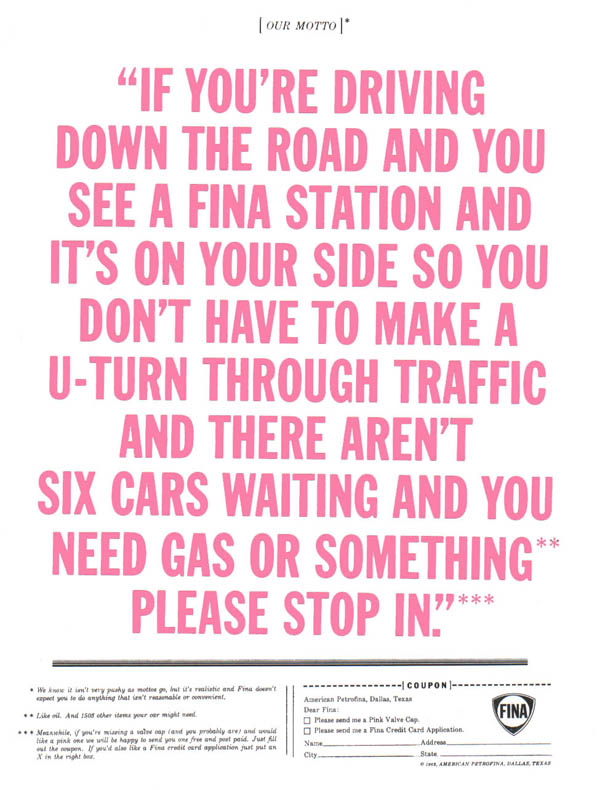Why Silly Stuff Matters
Always keen to jump on a passing bandwaggon, I wrote a piece for Campaign Asia inspired by Three’s ‘Dance Pony Dance’. It’s about silly stuff and why it matters in advertising. You can read it here.
Your browser (Internet Explorer 7 or lower) is out of date. It has known security flaws and may not display all features of this and other websites. Learn how to update your browser.
Always keen to jump on a passing bandwaggon, I wrote a piece for Campaign Asia inspired by Three’s ‘Dance Pony Dance’. It’s about silly stuff and why it matters in advertising. You can read it here.
In digital agencies, we love content personalisation. It makes us look smarter in front of clients and hopefully keeps things a bit more interesting for the people we’re trying to communicate with. But there’s also a downside to excessive personalisation – or at least that’s the message Eli Pariser made in his fascinating TED talk on the ‘filter bubble’ (thanks to Eduardo and Mervyn for sharing this).
Pariser describes how content providers like Google are increasingly personalising the information we see based on how likely we’ve been to click on similar topics in the past. The downside being that over time we see just the lazy stories that we like to read (eg What Justin Bieber thinks about the Royal Wedding), rather than the important events we should be aware of (eg the uprising in Egypt).
Pariser focuses on the impact of personalisation on news, but there’s also an important cultural implication. If what we consume becomes purely based on past behavior, over time we run the risk of creating a positive feedback loop where our tastes and attitudes become increasingly narrow and self-reinforcing. The fact that you’ve never visited a Vietnamese restaurant doesn’t mean you won’t enjoy the experience when you stumble on one.
The flipside of this argument is that we’ve always gravitated to information sources that resonate with our own world view – think Fox Sports or the UK’s Daily Mail. Furthermore, where once we only had a handful of TV channels, newspapers and local radio stations to form our opinions from, the internet now offers us access to attitudes we’d never of previously seen or heard about.
But it all comes down to our willingness to look for them. Personalisation has come about because most of us need help in making sense of the paralyzing volume of information available online. And in this way, it often helps us discover things we’d perhaps otherwise not have considered, for example Amazon’s recommendations.
If Google becomes our only frame of reference, there’s no doubt that Pariser’s vision is a chilling one. But ultimately it’s up to us to look beyond a single source of information and keep exploring.

The word ‘engagement’ gets used a lot by marketers these days – in fact a few new synonyms would be helpful for the digital strategy I’m working on at the moment.
For a lot of brands, creating content that consumers want to engage with is absolutely the right approach, particularly if it’s around a shared passion or topic that people actively want to discuss.
However, it’s easy to forget that in many of the purchasing decisions we make every day, we don’t want to be engaged, we just want to get it done with minimal fuss.
Rory Sutherland has a great piece on his blog about this phenomenon: his argument is that most people make most of their decisions based on minimising risk rather than optimising choice. In other words it’s not about making your brand the best – it’s about being the least likely to be shite. As a consumer, this is the difference between being a ‘maximiser’ and a ‘satisficer’:
“If you are an expert in a field, you are a maximiser. Your car is Teutonic. You listen to relatively obscure Indie music. You wear niche clothes brands, like those funny jeans with a wiggle on them…But most people tend to be maximisers in a few areas only – for most of us it’s simply too much intellectual effort to compete in every field.
Now, here’s the issue. Most people, in most fields of consumption, most of the time are NOT maximisers at all. They are something completely different. They are satisficers. What they are doing is not using insane amounts of mental energy to attempt to optimise every decison. They are instead simply trying to avoid making a decision that is actually bad or which might cause them to look or feel foolist. For those people, good enough generally is.”
Rory Sutherland: ‘Do people in the music industry understand music? And do people in the Advertising industry understand brands?’
This doesn’t mean do nothing. Using compelling content to increase your online visibility and credibility can be a great way of engaging the ‘maximisers’ while also making you seem less risky in the eyes of the ‘satisficers’.
Ultimately, it’s about understanding your different audiences and tailoring messaging accordingly. And as the the Fina ad cleverly acknowledges, it’s worth remembering that most of these people probably don’t care as much about your brand as you do.
Like many people with a blog, I don’t update it as much as I’d like.
Recently I’ve been trying to convince myself that this was not a result of my own laziness. Rather, I concluded that my previous image-led, magazine-style design was better suited to long-form articles than short posts and links. Predictably, this realisation resulted not in hard-hitting features but deliberation and inactivity.

The obvious conclusion was to go back to basics and redesign the blog. So here it is, hopefully with the help of Thesis, unmissable regular content will become the norm.